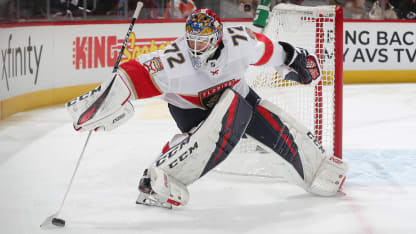"I've tried a few composites since they first came out, and every year they've gotten better and better," Elliott said. "It's light, but when I go back to my foam-core stick, it's night and day how much more comfortable I am. I just like how you can feel and direct pucks a little better with old-school sticks. You can absorb it a little better and control it. So I'm like, why switch?"
Some said they felt like they didn't have much of a choice.
Bobrovsky used a Warrior foam core last season but ran out of inventory after the company stopped working with the Canada-based manufacturer that made them. It opened the door for him to try something new during the offseason.
"I got a bunch of stuff to test just to be on top of things because the technology has developed a lot," Bobrovsky said. "I liked how on low shots, just put a little angle on the stick and the puck goes up into the net, and I like stick-handling, but definitely the biggest point is the lightness."
Carey Price of the Montreal Canadiens and recently retired goalie Roberto Luongo each played more than a decade using foam-core sticks but switched after injuries gave them a chance to try a composite.
Edmonton Oilers goalie Mike Smith switched in part because of inconsistencies in the supply of foam-core wood sticks, which is part of the challenge when working with natural materials.
"A big part if it is not having to worry about one being different from the other," Smith said.
Though Elliott prefers the softer feel and flex of a foam-core stick, the composite sticks have progressed significantly in that area. The different blends of carbon fiber and other impact- and vibration-dampening materials are designed to mimic the feel of wood. Durability has increased as well, with newer materials, including those used on the front wings of Formula One race cars, incorporated into the composition of the sticks.
As the newer sticks grow in popularity, so do their variety. Various models within brands offer different flex profiles, including ones that bend more in the shaft to make it easier to shoot the puck. As puck-handling becomes more refined for goalies, there are conversations about creating custom kick points like the ones used by forwards and defensemen to personalize their sticks to accentuate their shooting styles.

